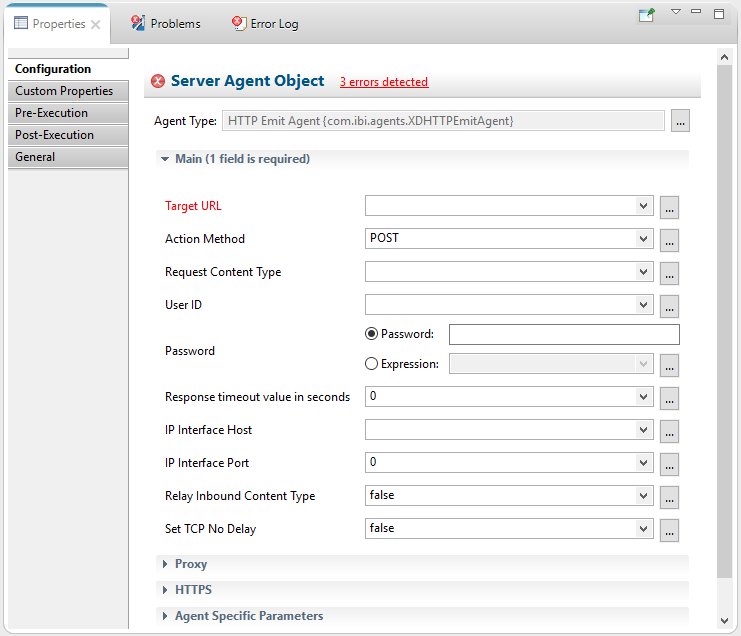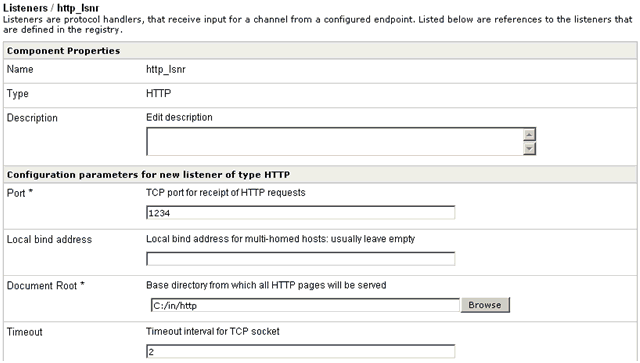HTTP Emit Service (com.ibi.agents.XDHTTPEmitAgent)
Syntax:
com.ibi.agents.XDHTTPEmitAgent
iIT Service Object:
emit: HTTP Emit Agent
http: HTTP Emit Agent
Description:
This service is a general HTTP emitter for use within the service stack. The document is posted using HTTP to a designated server.
Parameters:
|
Parameter |
Description |
|---|---|
|
Target URL * |
Specify a URL to post this information. |
|
Action Method |
Select one of the following methods from the drop-down list:
|
|
Response content type |
Overrides content type of response. Select one of the following options from the drop-down list:
|
|
User ID |
User ID for Basic Authentication challenges. |
|
Password |
Password for Basic Authentication challenges. |
|
Response timeout value in seconds |
Seconds to wait for response before signaling error. |
|
IP Interface Host |
Local IP Interface from which the outgoing IP socket originates. |
|
IP Interface Port |
Local IP Port from which the outgoing IP socket originates. |
|
Relay Inbound Content Type |
If set to true, relay headers as received (content type). Select one of the following options from the drop-down list:
|
|
Proxy |
|
|
Proxy |
If set to true, emit through proxy server. Select one of the following options from the drop-down list:
|
|
Proxy URL |
URL of the proxy server. |
|
Proxy User ID |
User ID for proxy challenges. |
|
Proxy Password |
Password to access the proxy server. |
|
HTTPS |
|
|
Secure Connection |
Use a secure connection. You may need to configure the Keystore under HTTPS section of the system properties if client authentication is required. Note, if keystore is configured in system properties make sure it has the CA certificate or the client certificate of the server you're connecting to. If keystore is not configured in system properties default truststore located under JRE_HOME/lib/security/cacerts will be used. Select one of the following options from the drop-down list:
|
|
Use 128-bit Encryption |
Enforces the use of 128-bit encryption. Select one of the following options from the drop-down list:
|
|
Security Protocol |
Select one of the following security protocols from the drop-down list:
|
|
Agent Specific Parameters |
|
|
Return * |
Return from this agent. Select one of the following options from the drop-down list:
|
|
Use Preemitters |
If set to true, preemitters will be used for this emit. Select one of the following options from the drop-down list:
|
|
Response Wrapper Tag |
The tag name with which to wrap the response if the response is non-XML and must be XML |
|
Response Base64 Encoded |
Determines whether the response should be Base64 encoded. Select one of the following options from the drop-down list:
|
The result of the post appears in the <native> section of the <emitstatus> result. If the Return parameter value is STATUS, the status message is always generated. If it is RESPONSE (the default) the actual information returned from the POST is emitted, except in the cases of an error in which case the status information is emitted. The POST is considered successful if the POST can reach its destination and a 200 status is received. A successful return response is considered to be XML if the first character is a <. Otherwise, a flat document is created.
Edges:
The following table lists the available line edges for the HTTP Emit Service (com.ibi.agents.XDHTTPEmitAgent).
|
Line Edge |
Description |
|---|---|
|
OnError |
Error |
|
OnSuccess |
Success |
|
OnFailure |
Failure |
|
OnCustom |
|
Example:
The following is an example of configuration settings for an HTTP Emit service object in iIT Designer:

A simple way to test your HTTP Read service is to first configure a channel that uses an HTTP listener as the inlet and a File emitter as the outlet to examine the messages that are received by the listener. Your HTTP listener configuration settings would look similar to the following example, where an HTTP port and a document root are specified.

After you deploy and start the channel with the HTTP listener and File emitter, you can test run your process flow, which contains an HTTP Emit service object. You must supply an incoming document with the appropriate content (for example, HTML):
<html>
<head>
<title>my iWay http</title>
</head>
<body> Testing HTTP Emit Service! </body>
</html>If the service runs successfully, you will receive this HTML document in the output folder that is specified by your File emitter. The HTTP listener channel picks up the document that is emitted by the HTTP Emit service.